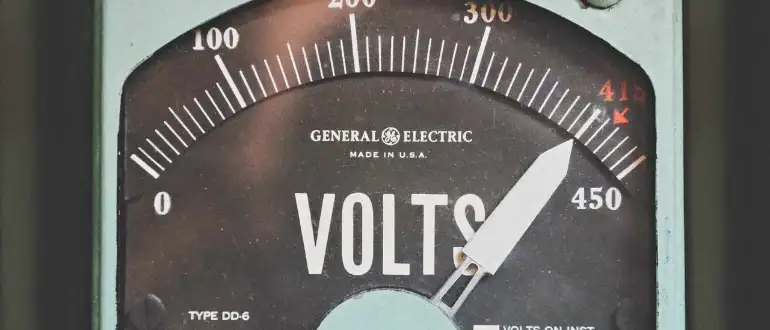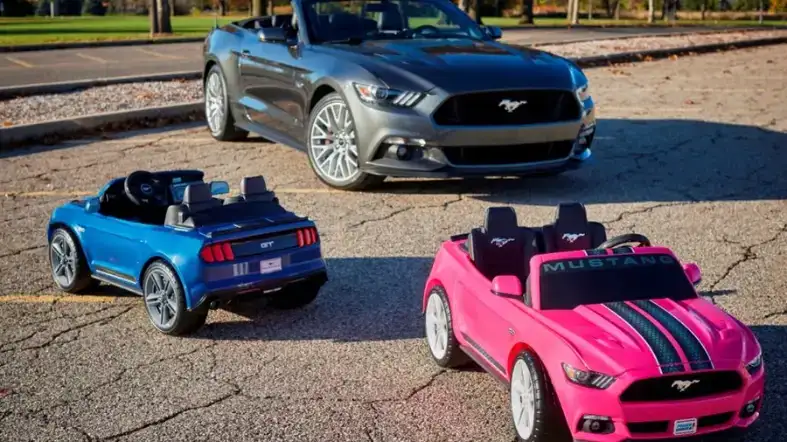Planning to upgrade your kid’s power wheel but concerned about the safety?
Want to know how many volts can power wheels handle so you can offer a safe toy based on their age and skill level?
Typically, the voltage that a Power Wheels toy car can handle varies depending on the specific model and battery type.
In this article, we’ve discussed the voltage of the most common Power Wheels model along with the benefits of upgrading and safety considerations.
How Many Volts Can A Power Wheels Handle?
The voltage that a Power Wheels toy car can handle varies depending on the specific model.

However, in most cases, the 6V battery is suitable for young children aged between 1-3 years, and the 12V battery is appropriate for children aged between 3-7 years.
The 24V battery is suitable for older children aged 7-10 years.
The Voltage of Power Wheels: What You Need to Know
the voltage of a Power Wheels battery plays a vital role in the performance of the vehicle.
Ensure that you choose the right voltage for your child’s age, usage, and terrain.
Additionally, remember to supervise your child while they’re using the vehicle and keep the battery in good condition to maximize its lifespan.
Apart from that the voltage of a Power Wheels battery determines the speed, acceleration, and run-time of the vehicle.
Lets get briefly about Power Wheels’ voltage:
Battery Life
The battery life of a Power Wheels vehicle depends on the voltage and usage.
Higher voltage batteries will provide a more extended run time than lower voltage batteries.
Ensure that you charge the battery correctly and keep it in good condition to maximize its lifespan.
Speed and Acceleration
Higher voltage batteries provide a more significant acceleration and speed for the vehicle.
However, it’s essential to remember that the higher the voltage, the more difficult it is to control the vehicle.
Therefore, you must supervise your child while they’re using the vehicle.
Terrain
The terrain on which the Power Wheels vehicle will be used is also an essential factor to consider when choosing the battery voltage.
A 6V battery may not be powerful enough to handle rough terrain, whereas a 24V battery may be too powerful for flat terrain.
Consider where your child will be using the vehicle and choose the appropriate voltage.
Common Voltage Limits for Different Power Wheels Models

Power Wheels is a well-known brand of battery-operated vehicles for children, and they come in different models and voltages.
Understanding the common voltage limits for different Power Wheels models is essential to ensure that you choose the right vehicle for your child.
Let’s take a closer look at some of the most popular Power Wheels models and their voltage limits.
Power Wheels Jeep Wrangler
This model is one of the most popular Power Wheels vehicles and comes in 6V, 12V, and 24V versions.
The 6V battery is suitable for young children aged between 1-3 years, while the 12V battery is appropriate for children aged between 3-7 years.
The 24V battery is suitable for older children aged 7-10 years.
Power Wheels Dune Racer
The Power Wheels Dune Racer is another popular model that comes in 12V and 24V versions.
The 12V battery is suitable for children aged between 3-7 years, while the 24V battery is suitable for older children aged 7-10 years.
Power Wheels Ford Mustang
The Power Wheels Ford Mustang is a popular model that comes in 12V and 24V versions.
The 12V battery is suitable for children aged between 3-7 years, while the 24V battery is suitable for older children aged 7-10 years.
Power Wheels Kawasaki KFX
The Power Wheels Kawasaki KFX is a popular ATV-style vehicle that comes in 12V and 24V versions.
The 12V battery is suitable for children aged between 3-7 years, while the 24V battery is suitable for older children aged 7-10 years.
Here is a chart that summarizes the common voltage limits for some popular Power Wheels models:
| Power Wheel Model | Voltage Limit |
|---|---|
| Jeep Wrangler | 6V, 12V, 24V |
| Dune Racer | 12V, 24V |
| Ford Mustang | 12V, 24V |
| Kawasaki KFX | 12V, 24V |
The Maximum Voltage of Power Wheels

The motors are one of the most critical elements in determining your Power Wheel’s maximum capacity.
The motors use the electricity from the batteries to drive the gears and efficiently cause the wheels to rotate.
Battery capacity is usually close to the engine’s maximum.
For example, if your Power Wheels come with a 24V motor but 12V batteries, you may swap the batteries to a 24V battery.
The motors aren’t the only vehicle components that influence your Power Wheels’ maximum voltage.
Read More: Can You Put A Remote Control On Power Wheels?
Other power wheel parts, such as the gears, tires, and other elements, also impact a car’s ability to accommodate voltage increases.
This is why you need to choose a compatible battery for your Power Wheels car, as it is most compatible with your car or propulsion system.
That implies you should probably stick to the battery that came with your Power Wheels.
Despite warnings from manufacturers, some consumers continue to overvolt their Power Wheels batteries, which is referred to as overvolting.
Read More: Why Won’t My Power Wheels Move?
The Benefits of Higher Voltage in Power Wheels
higher voltage can bring many benefits to your child’s Power Wheels, including improved speed, durability, battery life, suitability for older children, and more fun.
However, it’s essential to choose an appropriate vehicle and supervise your child while they’re using it to ensure their safety.
Here are a few key advantages of higher voltage in Power Wheels:
Improved Speed
Higher voltage means more power, which translates to faster speeds for your child’s Power Wheels.
This can enhance the overall riding experience and make it more pleasant for your child.
Increased Durability
With higher voltage, your child’s Power Wheels can handle tougher terrain and obstacles without getting stuck or bogged down.
It can also improve the vehicle’s ability to climb inclines and handle rough surfaces.
Longer Battery Life
Higher-voltage batteries tend to last longer than lower-voltage ones. This means your child can enjoy extended playtime without recharging the battery frequently.
Suitable for Older Children
Some Power Wheels models come with higher voltage batteries that are more suitable for older children.
These models often have larger motors and can handle the weight of older children without compromising on performance.
More Fun
Ultimately, higher voltage can make your child’s riding experience more fun and exciting.
Your child can enjoy faster speeds, better handling, and more power, which can enhance their overall enjoyment of their Power Wheels vehicle.
It’s important to note that while higher voltage can bring these benefits, it’s essential to choose a vehicle that’s appropriate for your child’s age, weight, and skill level.
It’s also crucial to supervise your child while they’re using the vehicle and ensure they wear proper safety gear, such as a helmet and knee pads.
Safety Considerations When Increasing Voltage in Power Wheels

Increasing voltage in Power Wheels can bring numerous benefits, but it’s crucial to consider safety when doing so.
Follow the manufacturer’s age and weight limitations, ensure proper installation, ride on appropriate terrain, and wear safety gear.
You should also maintain the battery correctly to ensure your child’s safety while using their Power Wheels vehicle. The safety considerations are:
Age and Weight Limitations
It’s crucial to follow the age and weight limitations specified by the manufacturer when choosing a higher-voltage battery.
Older children and teenagers may be able to handle more voltage, but younger children may not be able to handle the additional speed and power.
Proper Installation
Upgrading your child’s Power Wheels with a higher voltage battery requires proper installation.
It’s essential to read the manufacturer’s instructions carefully and follow them precisely to ensure the battery is installed correctly.
Appropriate Terrain
Higher voltage batteries can make Power Wheels vehicles more powerful and faster, but they can also make the vehicle more challenging to control.
It’s crucial to ensure that your child only rides on appropriate terrain that’s suitable for their skill level and the vehicle’s capabilities.
Safety Gear
It’s crucial to ensure that your child wears appropriate safety gear when riding their Power Wheels, regardless of the voltage.
A helmet, knee pads, elbow pads, and closed-toe shoes can help prevent injuries in the event of an accident.
Battery Maintenance
Higher voltage batteries can put more strain on the Power Wheels vehicle’s motor and other components.
It’s essential to maintain the battery properly and avoid overcharging or leaving it on the charger for an extended period.
FAQs
1. How Do You Know The Power Wheel Battery Voltage?
It is very easy to know the power wheel’s battery voltage.
If you want to know the power wheel’s battery voltage, you can read the product’s specifications.
Or, the power wheels have a little level attached to the battery cartridge of the car, where the battery’s voltage is specified.
An even easier way is to read the user manual that comes with the car.
After all, you will be able to know the toy car battery voltage using a voltmeter.
2. Is A 24-Volt Battery Faster Than A 12-Volt Battery?
Yes. Of course, a 24-volt power battery is much faster than a 12-volt battery.
A 24-volt battery in a Power Wheels car can reach a maximum speed of 6 miles per hour, whereas a 12V battery can reach a speed of 6mph. Voltage is not a factor.
The speed of your power wheels will depend on other factors, such as the rider’s weight and the terrain.
On the other hand, the battery’s voltage does not affect the speed of charge or discharge.
The only thing that affects the voltage is the amount of energy that can be stored in the battery.
3. Can I Put A 12V Battery In A 6v Power Wheel?
Yes. You can use a 12-volt battery in a 6V volt power wheels car.
However, the 8-volt power wheels are not designed for 12-volt batteries.
But if you want to get the best results from it, you need to make some adjustments to the car’s wiring system and electronic components, such as converters and motors.
If you do not replace the battery with other components, your power wheel may be damaged.
It’s important to read the instructions that come with the power wheel to make sure you’re doing everything right.
Final Thoughts
Understanding the voltage capacity of your child’s Power Wheels toy is crucial for their safety and enjoyment.
By following the manufacturer’s guidelines and monitoring the battery level, you can ensure that your child has a fun and safe experience with their toy.
Whether you opt for a 6-volt or 24-volt model, remember to always supervise your child while they are using their Power Wheels and teach them how to operate them safely.
With proper care and attention, your child’s Power Wheels can provide hours of entertainment and adventure.